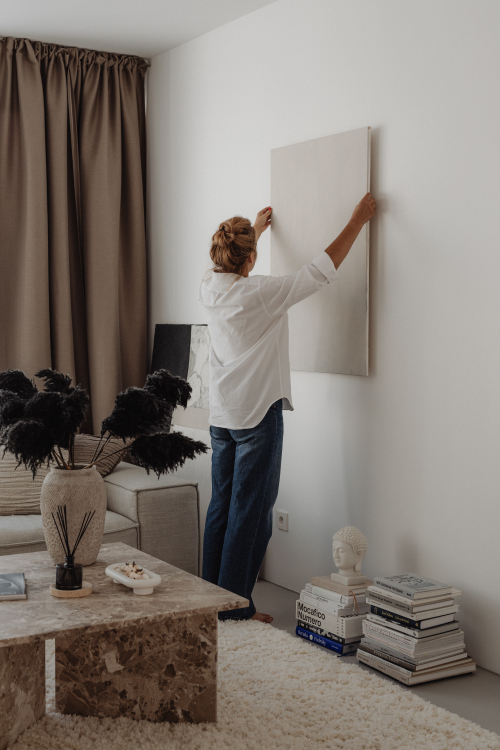
Dreaming of a quaint English cottage-style kitchen? Whether you’re considering a full-scale remodel or just want to add a little cottage kitchen decor to your existing space, I have a few tips I’d like to share with you from our trip. Over a year ago we started remodeling our kitchen from a standard suburban space to an English country cottage kitchen. From the initial planning stages to the finishing touches, our kitchen has evolved into a functional and charming space.
Specifically, there are six design principles that I’ve learned along the way and I hope you find them inspiring and helpful in designing and decorating your cottage-style kitchen.
#1 Use Repetition in Cottage Kitchen Decor
Repetition of color, shape or pattern is key to creating a cohesive look. Whether you realize it or not, your eye will recognize repeated elements in the design and automatically register that they belong. That’s why collections of similar items seem appropriate. Knowing this, I repeated certain colors, structural elements and decorative elements.
Wooden items: It was an easy material to work with since we already had the butcher block countertop and bamboo blinds. To these warm wood tones, we added practical and homely baskets for storage, a vintage dough bowl, and wooden kitchen utensils.
Blue and white decoration: This was fun for me because I’ve loved the crisp, timeless color combination of blue and white since I was eighteen. To the blue and white patterned Zellige tiles we installed as our accent wall behind the stove and as a backsplash behind the sink, I add the vintage plates and platters to the dish rack along the kitchen top.
I then repeated these colors on the fruit bowl, salt shaker, sugar bowl, utensil holder, and our hand towels. There is no maximum number of times you should repeat a color, pattern or decorative piece, but it is essential to have at least three, as that is when your eye will recognize an intentional design.

Copper: You will see copper in some places. First, on the pendant bases above the peninsula, then on the teapot and pot on the stove, on the tray on the counter, and the two antique baby jelly molds hanging on the wall. It’s a good idea to distribute items around the room to create a feeling that the space is included as a whole. This is the opposite approach to displaying a collection of similar things.

#2 Create a Cohesive color palette
Sticking to a well-defined color palette simplified our purchasing and decorating process. She made sure that every element we brought into the kitchen felt like it belonged, contributing to the overall unity of the space. For our decor, we used repeated pops of soft blue to match the sage green and ivory that already dominate the space. Additionally, by sticking with warm metallic finishes of brass and copper, we maintained a sense of unity in the space.

#3 Use unique elements for personality
I surely wanted to create a look in our kitchen that had a unique personal touch. So to avoid a cookie-cutter look, I pulled from my inspiration photos items that aren’t typically used in kitchens, like lamps and art.

- The world of vintage lighting is unique! With so many eras, shapes, sizes and colors to choose from, this is a great place to personalize any space. Additionally, you can perfectly adapt any lamp to your taste by making a handmade lampshade to complement your vintage lamp. For a dark corner of the kitchen (where we spend a lot of time cooking) I added a second-hand vintage French bouillette for $7. It’s the perfect size for the space, has simple but interesting lines and a gold-lined shade that casts the most delicious warm light.

- This antique hand-colored lithograph was recently discovered at my favorite antique store. Not only does it fit perfectly into the space and depict an English castle, but the black frame also matches the black screen (unintentional repetition!). Note: The more you study to develop your eye and stick to a color palette, the more little surprises like this will appear.
#4 Refine the ordinary
This decorating step is immensely fun for me! We all need soap to wash dishes, scrubbers, etc. But that doesn’t mean they have to be neon green, hot pink, or in ugly plastic containers. With a little imagination and effort, even ordinary, everyday items can be transformed from mundane to beautiful.
Often the area around the kitchen sink sees heavy daily use and can reflect this by looking worn and neglected. For this reason, special attention was paid to all the daily cleaning items used. An old English sugar bowl was spotted on Etsy containing wooden brushes with fairly long handles for scrubbing those pots and pans.

An ironstone dish was obtained for about $5 and was used to hold a beautifully scented block of ground French soap and a wooden palm scrub brush. Everything you need to wash your hands and dishes and enjoy the process!

#5 Mix materials for a custom look
A valuable lesson I have learned from British interior designers is to be quite eclectic in choosing materials and mixing them freely. We mixed the materials of our countertops and backsplashes, creating a personal feeling of liveability in our kitchen.
In addition to mixing hard surfaces, we’ve also combined different warm-toned metals, like copper pendants and cookware, with a brass faucet and hardware for added depth and texture. I also mixed some English china plates with the soft blue antique transferware to shake it up a bit. One of the distinctive characteristics of the English country style is the mixed or mismatched elements.

#6 Create Designer Vignettes Versus Clutter
Have you ever wondered if there was a way to organize things so that they looked pretty and intentional instead of a bunch of clutter? Me too! When I look at cottage kitchen decor in a magazine, it often looks very designed and intentional. But in my house it can sometimes seem like a jumble of things.
A good starting point is with an anchor piece. An anchor piece will define the space where decorative items will go, keep things organized, and limit what will be included in the group. You can anchor your arrangement in two different ways: either from below with a platter, marble slab, or butcher block, or from behind with a piece of art or a tray.
In the photo above, a large dough bowl from the antique store contains an arrangement of flowers and usually fruit. It’s on the shopping list!
In the photo below, I used a covered tray to grind the scrub brushes and butter dish. The tray not only helps group items, but also hides the power outlet.

When deciding what will be included in a “designer vignette,” I tend to start with what is needed in that area or work zone. I then collect the items and play with them until everything needed fits attractively into the given space.
One of those hard work areas is right next to the stove. This space is used several times a day and needs to be thought through carefully to make it as useful as possible. This family of items is supported by a large white ironstone fountain. In this area we needed kitchen utensils, pepper (the salt sits on the back of the stove) and sugar found in the old gravy boat.
Tip: Don’t be afraid to use things in ways other than intended. It took a little fiddling to get it right, but how rewarding when each day exactly what we need to cook is on hand ~ and it’s so pretty! Here are some more ideas to avoid the cluttered look.
- Keep only the essential and beautiful items in view.
- Cottage kitchen decor should be practical and beautiful.
- Evaluate and rearrange items periodically to maintain a balanced appearance. This may mean changing things up based on changing seasonal culinary needs.

If you’re still wondering where to start, I recommend adding home kitchen decor to your space by checking out interior design books at your local library, purchasing them secondhand at half price books, or online. (One of my favorites is It feels like home by marian parsons.) I have several of my favorites listed on our Cabin Resources page.
I have found my interior design books a source of inspiration time and time again. There is something about holding an image in your hands that allows you to study it and absorb it. I often find that I get my best ideas from these sources. “The Country Decorator” in particular provided not only visual inspiration but also practical tips for achieving that authentic cottage feel in our kitchen.
Thank you for joining us on this wonderful journey! We hope our kitchen remodel has inspired you to create a space that resonates with your style and brings you joy every day. Until next time, continue cultivating home art from the heart with your hands.











